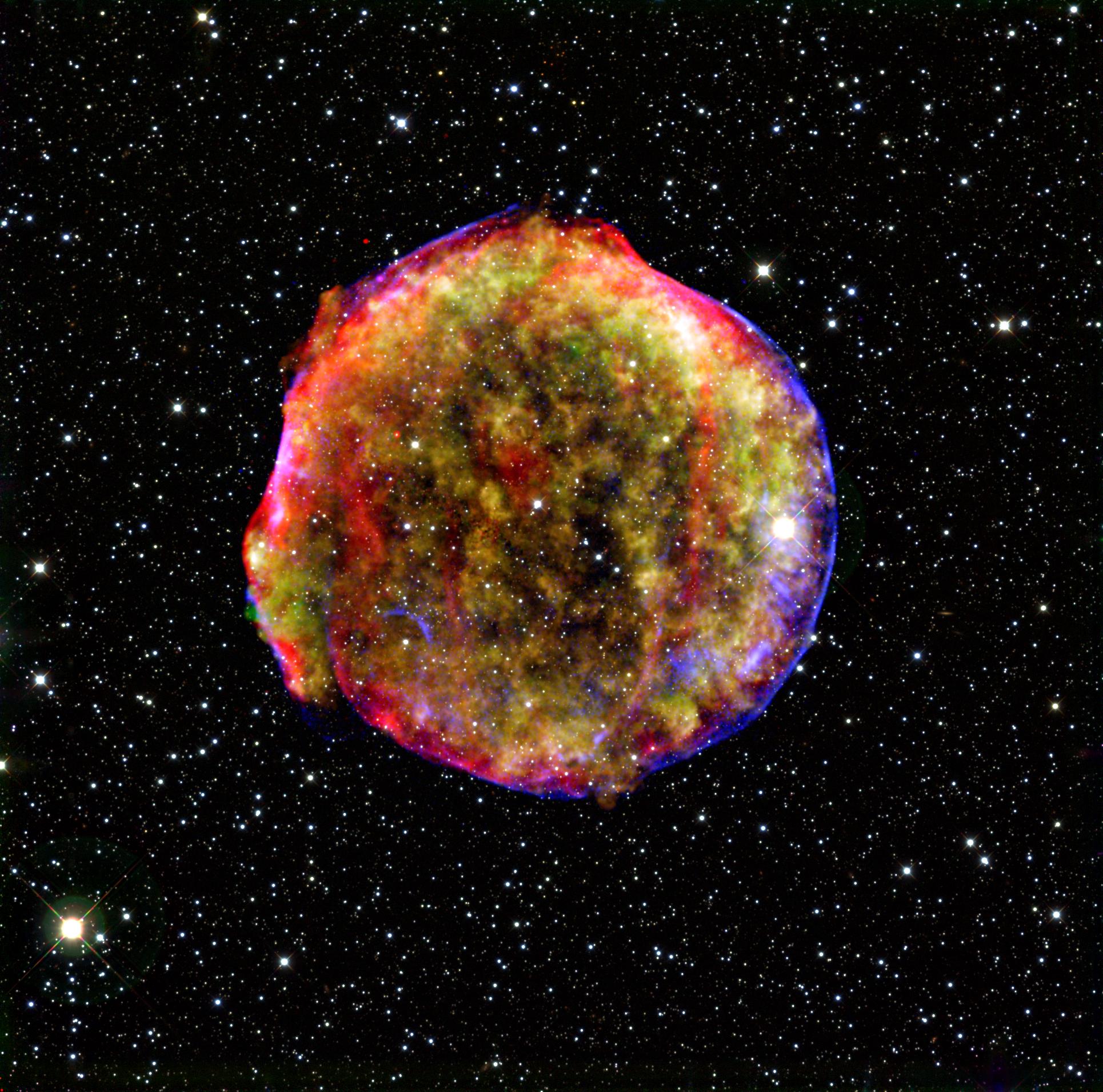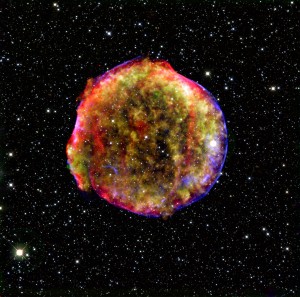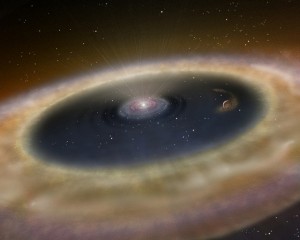These rocks just got a little bit older

Have you ever had a moment when person responds to you in a way that just makes you feel a little bit older than you did before? You comment, for example, about a music group to someone, only to be met with that incredulous stare that conveys the message to you that their parents liked that music, and that you must be a little older than you at first appeared.
An international research team just gave the Earth such a moment. The researchers did this, not by experimenting on musicians, rather by measuring the radioactive decay of samarium-146; one of the isotopes used to chart the evolution of the Solar System.
By using a more precise technique to remeasure the half-life of samarium-146, they shrank the chronology of early events in the solar system, like the formation of planets, into a shorter time span. It also means some of the oldest rocks on Earth would have formed even earlier. Some Australian rocks forming as early as 120 million years after the solar system formed.
Understanding how a seemingly simple measurement, such as the half-life of samarium-146, can have such far-reaching results will take us on an exhilarating journey through many areas of science.
How did our Solar System form?
According to current theory, everything in our Solar System formed from stardust several billion years ago. Some of this dust was formed in giant supernovae explosions. These explosions then supplied most of the heavy elements for the objects that make up our Solar System. The synthesis of the elements we see on Earth, in rock samples from the Moon and Mars, as well as from meteorites and asteroids, is a subject of great interest. By understanding the physics of the nucleo-synthesis of the isotopes of these elements it has become obvious that the dust and molecules that coalesced to form our solar system came from a number of different processes.

The formation of the terrestrial planets (the rocky planets Mercury, Venus, Earth, Mars and their respective moons) is generally divided into three major stages based on the different physical processes involved and their respective time scales: (1) the stardust aggregates into planetismals, like individuals forming into swarms of nomadic tribes; (2) then runaway and oligarchic growth of embryos from planetismals resulting several tens to 100 Lunar- to Mars-mass embryos embedded, like mediaeval barons, in a swarm of remnant planetismals; and (3) the final stage of terrestrial planet formation by high-velocity impacts between embryos over a span of ~10-100 million years, forming the planets as we know them.
The Allende meteorite and the age of the Solar System
The age of the Solar System can be defined as the time of formation of the first solid grains in the nebular disk surrounding the proto-Sun. This age is estimated by dating calcium-aluminium-rich inclusions in meteorites. All chronology, by convention, is referenced to T0, which is the abbreviation for the age of the oldest known solid material in the solar nebula.
Scientists have found that calcium-aluminum-rich inclusions are some of the oldest objects in the solar system. These inclusions, roughly millimetres to centimetres in size, are believed to have formed very early in the evolution of the solar system and had contact with nebular gas, either as solid condensates or as molten droplets.
Relative to planetary materials, calcium-aluminium-rich inclusions are enriched with the lightest oxygen isotope and are believed to record the oxygen composition of solar nebular gas where they grew. Calcium-aluminium-rich inclusions, at 4.57 billion years old, are millions of years older than more modern objects in the solar system, such as planets, which formed about 10-50 million years after them.
In recent research, a US team led by Justin Simon from NASA Johnson Space Centre and University of California Berkeley, studied a specific calcium-aluminium-rich inclusion found in a piece of the Allende meteorite. Allende is the largest carbonaceous chondrite meteorite ever found on Earth. It fell to the ground in 1969 over the Mexican state of Chihuahua and is notable for possessing abundant calcium-aluminium-rich inclusions.
Carbonaceous chondritic meteorites are stony meteorites that have not been modified due to melting or differentiation of the parent body. They formed in oxygen-rich regions of the early, first stage, Solar System so that most of the metal is not found in its free form but as silicates, oxides, or sulfides. Most of them contain water or minerals that have been altered in the presence of water, and some of them contain larger amounts of carbon as well as organic compounds. The Allende meteorite is a ‘pristine’ meteorite, so called because its provenance is known. It was found and sampled under conditions that precluded contamination from terrestrial chemicals and minerals.
Their findings imply that calcium-aluminium-rich inclusions formed from several oxygen reservoirs, likely located in distinct regions of the solar nebula. Calcium-aluminium-rich inclusions travelled within the nebula by lofting outward away from the sun and then later falling back into the mid-plane of the Solar System or by spiralling through shock waves around the Sun.
Through oxygen isotopic analysis, the team found that meteorite material surrounding the calcium-aluminium-rich inclusion show that late in the calcium-aluminium-rich inclusion’s evolution, it was in a nebular environment distinct from where it originated. This latter region was closer in composition to the protoplanetary disk, the environment in which the building materials of the terrestrial planets formed. A protoplanetary disk is an area of dense gas surrounding any newly formed star. In this case, the calcium-aluminium-rich inclusion formed when our Sun was quite young.

The formation of the Solar System as we know it today, was complex and dynamic process. The protoplanetary disk evolves through accretion to the star, the particles and molecules being gravitational attracted to the proto-Sun. Each particle’s attraction was mediated or dampened by collisions, the viscous drag of the gaseous nebula, coupled with an outward ‘fling’ due to their angular momentum.
Radioactive dating the age of the Solar System
Timescales of early Solar System processes rely on precise, accurate and consistent ages obtained with radiometric dating. The relative abundance of different nuclei and their correlation or non-correlation with models of their formation and their radioactive decay provide a series of clocks to determine when and how material was formed.
Recent advances in instrumentation now allow scientists to make more precise measurements. Some of these measurements are revealing inconsistencies in the ages of samples as well as clearing up existing inconsistencies.
For example, recent analysis, by Audrey Bouvier and Meenakshi Wadhwa from Arizona State University, of the meteorite, Northwest Africa 2364, found that the age of the Solar System predates previous estimates by up to 1.9 million years. They used a radioactive chronometer based on the decay of isotopes of uranium to lead.
By using this lead-lead dating technique these researchers were able to calculate the age of a calcium-aluminium-rich inclusion contained within the Northwest Africa 2364 chondritic meteorite. In lead-lead dating the lead isotope, 207Pb/206Pb ratios are measured; these lead-207 and lead-209 isotopes are the decay products of the uranium isotopes 235U and 238U respectively.
The study’s findings fix the age of the Solar System at 4.5682 billion years old, between 0.3 and 1.9 million years older than previous estimates. This relatively small revision to the currently accepted age of about 4.56 billion years is significant since some of the most important events that shaped the Solar System occurred within the first ~10 million years of its formation.
This relatively small age adjustment means that there was as much as twice the amount of iron-60, a certain short-lived isotope of iron, in the early Solar System than previously determined. This higher initial abundance of this isotope in the Solar System can only be explained by supernova injection. The researchers believe the supernova event, and possibly others, could have triggered the formation of the Solar System. By studying meteorites and their isotopic characteristics, they bring new clues about the stellar environment of our Sun at birth.
This work also helps to resolve some long-standing inconsistencies in early Solar System time scales as obtained by different high-resolution chronometers. The story is not yet complete, it will be important to conduct high precision chronologic measurements of calcium-aluminium-rich inclusions from other pristine meteorites. We also need to understand the reasons why the calcium-aluminium-rich inclusions measured previously from two other chondritic meteorites, Allende and Efremovka, have yielded younger ages.
One significant aspect of this study is that it is the first published lead-lead isotopic investigation that takes into account the possible variation of the uranium isotope composition. Earlier work conducted in Wadhwa’s laboratory by a graduate student Gregory Brennecka, in collaboration with Ariel Anbar, has shown that the uranium isotope composition of calcium-aluminium-rich inclusions, long assumed to be constant, can in fact be highly variable and this has important implications for the calculation of the precise lead-lead ages of these objects.
Using the relationship demonstrated by Brennecka and colleagues between the uranium isotope composition and other geochemical indicators in calcium-aluminium-rich inclusion, Bouvier and Wadhwa inferred a uranium isotope composition for the calcium-aluminium-rich inclusion for which they reported the lead-lead age.
This work can help researchers better understand the sequence of events that took place within the first few million years of the Solar System formation, such as the accretion and melting of proto-planetary bodies. All these processes happened extremely rapidly, and only by reaching such a precision on isotopic measurements and chronology can we find out about these processes of planetary formation.
The importance of the half-life of the isotope samarium-146
As well as the lead-lead dating technique the radioactive chronometer based on the isotope samarium-146 is one of interest for this story. Samarium-146, or 146Sm, is unstable and occasionally emits an alpha particle, a helium-4 particle, which changes the atom into a different element, neodymium-142.
As samarium-146 decays slowly—on the order of millions of years—many models use it to help determine the age of the Solar System. In particular, in models of terrestrial planetary formation, rather than dating calcium-aluminium-rich inclusions in meteorites used in studying early Solar System formation.
Although samarium-146 decays slowly, it is still short compared to the time-scale of solar system evolution. For a known number of any isotope type, the number of years it takes for this to radioactively decay by half of its number, is called its half-life. Since samarium-146 emits particles so rarely, it takes a sophisticated instrument to measure this half-life. The half-life of samarium-146 allows its use as a determinator of the time between the end of its synthesis in the early Solar System and the inclusion of it in a solid body in the solar system.
What scientists look for are disparities in the relative abundances of samarium isotopes in terrestrial rocks and in the relative abundances of samarium and neodymium and neodymium isotopes. The reason for interest in the samarium-146 to neodymium-142 is that the half-life means that samarium-146 present at the time of solidification would no longer be available for observation at the present-time; it all will have decayed to neodymium-142. Therefore the isotopic composition of neodymium will vary with the amount of samarium, which was present at solidification.
The researchers remeasured the half-life of samarium-146 using the sophisticated instrument at the Argonne Tandem Linac Accelerator System, Kanazawa University, and the University of Tsukuba in Japan. What they did was very clever and very precise.
Firstly, they synthesised samples of samarium-146, in three independent nuclear-synthesis reactions, from samples of isotopically enriched samarium-147. The different techniques gave analysis samples with different contaminants and samarium-146 levels. Secondly, they measured the decay of these samples over a period of months using highly accurate detectors.
The Argonne Tandem Linac Accelerator System was then used as a mass spectrometer, in two different experimental set-ups, to pick out the small number of samarium-146 in the samples, one in tens of billions of atoms. These measurements took into account contributions from contaminants such neodymium-146, which caused contamination problems in earlier experiments. Neodymium-146 has the same atomic mass as samarium-146, and in mass spectroscopic measurements they cannot easily be separated.
By accurately counting the number samarium-146 atoms and tracking the particles that the sample emits, the team came up with a new calculation for its half-life: just 68 million years.
This is significantly shorter than the previously used value of 102.6 and 103.1 million years of recent (1966 and 1987 respectively) measurements. At the same time the result is closer to earlier measurements of ~50 million years and 74 million years from 1953 and 1964 respectively.
A new samarium-146 half-life measurement; now what?
The new value patches some holes in current understanding. The new time scale now matches up with a recent, precise dating taken from a lunar rock, and is in better agreement with dates obtained with other chronometers.
Applying this new half-life to rocks from Greenland and Australia gives them revised ages. These rocks are now dated to be 50 million years older than previously thought. That is they were formed only 120 million years after T0, the time of solar system formation, rather than the 170 million years from previous results. Similarly rocks from Quebec were found to be over 80 million years older than previous measurements. These are now found to have formed 205 million years, rather than 287 million years, after Solar System formation. These results illustrate that the events that formed terrestrial rocks occurred at much earlier ages than we even recently thought.
Analyses of moon rock samples have also shown an increase in their ages, in this case by over 70 million years. These are now found to have formed 170 and 175 million years, rather than 242 and 250 million years respectively, after Solar System formation. These new lunar results now bring ages of these rocks, using two different chronometers, the samarium-146 and lead-lead techniques, into the same ranges.
The early days of Earth and the other terrestrial planets are looking quite different than previously thought. All this is thanks to some precision measurements of the half-life of an extinct isotope of an exotic rare-earth element, samarium.
 Follow
Follow
Great article Kevin, I think that any explaination about the errors in the percived ‘things we really should know’ is long overdue! I’m always peturbed though that revision of these ages always states them as older – is there something the technique of radiometric dating is missing?